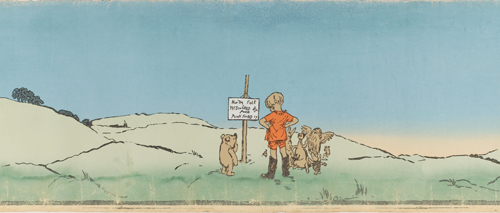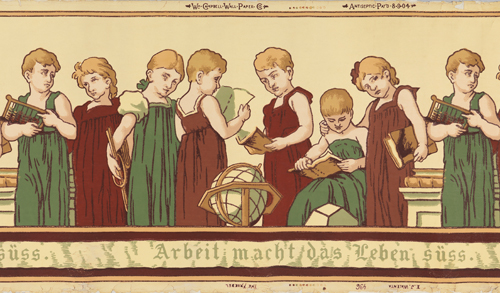The early years of the twentieth century were the high point in children’s room decoration. The Industrial Revolution brought about increased wealth, and children were given their own rooms for the first time. The decoration of a child’s room was supposed to be stimulating and educational, and needed to clearly designate the space as belonging to a child. Facilitated by advances in washable wallpapers and color printing in the late nineteenth century, the walls of children’s rooms were soon covered with multiple sidewall and frieze papers. 
Child’s bedroom or nursery, in Color Schemes for the Home and Model Interiors by Henry W. Frohne and Alice F. & Bettina Jackson United States, 1919
Frequently, the dominant decorative element in the room was a wide decorative frieze, which could contain an almost unlimited array of nursery rhymes, views of foreign lands, and lessons to be learned, to educate as well as entertain. It was usually recommended to hang the frieze just above a child’s reach, with a washable wallpaper or oil cloth below, and a lightly patterned wallpaper above. A narrow shelf could be installed at the bottom of the frieze to hold toys or collected objects.

Frieze: Winnie the Pooh | England, after 1926 Block-printed on ingrain paper Cooper-Hewitt, National Design Museum, Smithsonian Institution Gift of Standard Coated Products, 1975-2-2 Photo: Matt Flynn
One of the most charming and unusual wallpapers produced during this time was the Winnie the Pooh frieze, created after 1926. Faithfully copying the original E. H. Shephard illustrations in A. A. Milne’s classic book, the frieze illustrated the chapter in which “Christopher Robin Leads an Expotition sic to the North Pole.” The frieze, 22 inches high by 40 feet long, was long enough to wrap around a normal-sized bedroom, with each scene appearing once. Produced in England, each of the illustrations was woodblock-printed in color and joined together with an idyllic landscape, which created a continuous journey.

Frieze: The Froebel [Work Makes Life Sweet] Designed by E. J. Walenta. Produced by Wm. Campbell Wall Paper Company. Hackensack, NJ, 1905 | 122 × 49.4 cm (48 1/16 × 19 7/16 in.) Cooper-Hewitt, National Design Museum, Smithsonian Institution Gift of Paul F. Franco, 1938-50-15 Photo: Matt Flynn
Decorative friezes, first popularized by Walter Crane’s 1896 May Tree, were very popular in children’s rooms, with new designs produced through the 1920s. While extreme creativity flourished in children’s wallpaper design during the early twentieth century, this trend came to an abrupt halt with the onset of the Great Depression in 1929. From then on, rooms were designed to grow with the child, at minimal cost. So out went the nursery papers and in came plaids and stripes. Pictures, displayed hobbies, and collections, which were easily changed as the child matured, became the new way to identify the room as belonging to a child.